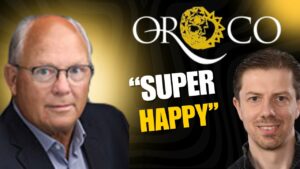HALIFAX, NOVA SCOTIA September 24, 2013 Oceanus Resources Corporation (TSXV:OCN) (“Oceanus” or the “Company”) is pleased to announce that diamond drilling has intersected high-grade gold and silver mineralization at both the Santo Nino and Dos Hermanos gold-silver prospects located on the La Lajita property in Durango, Mexico. Highlighted assay results include the following;
- 7.1 g/t gold and 48.8 g/t silver over a core length of 20.0 meters, including 18.9 g/t gold and 71.3 g/t silver over a core length of 6.5 meters in diamond drill hole OCN-13-005 located at the Santo Nino prospect.
- 10.2 g/t gold and 143.0 g/t silver over a core length of 1.7 meters in diamond drill hole OCN-13-002 located at the Dos Hermanos prospect.
“We are extremely pleased to have intersected two high-grade clavos in our first pass of diamond drilling and believe there are more to be found. The clavos located in the Upper Volcanic Series are open along strike and down dip and we are in the planning stages to drill test the extensions, targeting where they would intersect the andesitic rocks of the Lower Volcanic Series. The majority of the large multi-million ounce gold and silver deposits in the Sierra Madre, including Ocampo, Pinos Altos and Tayoltita occur at the contact between the Upper and Lower Volcanic Series”.
Significant drill intersections are reported below.
| 2013 La Lajita Diamond Drill Hole Intersections | ||||||||
|---|---|---|---|---|---|---|---|---|
| Target | DDH # | Comment | From (m) | To (m) | Length* (m) | Au (g/t) | Ag (g/t) | EqAu50** (g/t) |
| Dos Hermanos | OCN-13-001 | 47.3 | 57.4 | 10.1 | 1.82 | 70.7 | 3.23 | |
| including | 49.4 | 56.3 | 6.9 | 2.59 | 94.1 | 4.47 | ||
| Dos Hermanos | OCN-13-002 | 49.6 | 64.0 | 14.4 | 1.70 | 62.9 | 2.96 | |
| including | 51.6 | 53.3 | 1.7 | 10.17 | 143.0 | 13.03 | ||
| Dos Hermanos | OCN-13-003 | 65.6 | 92.6 | 27.0 | 0.48 | 22.7 | 0.94 | |
| including | 66.3 | 69.3 | 3.0 | 2.58 | 46.8 | 3.52 | ||
| Santo Nino | OCN-13-004 | 57.8 | 76.5 | 18.8 | 0.58 | 10.3 | 0.78 | |
| including | 57.8 | 59.5 | 1.8 | 3.29 | 25.9 | 3.81 | ||
| Santo Nino | OCN-13-005 | 66.6 | 86.6 | 20.0 | 7.09 | 48.8 | 8.07 | |
| including | 70.6 | 77.1 | 6.5 | 18.87 | 71.3 | 20.30 | ||
| Dos Hermanos | OCN-13-007 | 246.1 | 247.8 | 1.7 | 3.98 | 97.7 | 5.93 | |
** EqAu50** = Ag grade/50 + Au grade
2013 Drill Program
The recent diamond drill program consisted of seven holes totaling 938 meters of HQ and NQ core drilled to test the down dip extensions of the gold-silver mineralization exposed in surface trenches and shallow workings at two of the seven know gold-silver prospects; Dos Hermanos and Santo Nino. The drilling confirmed at both prospects, the fault breccia dips to the southwest at 50 degrees from the exposures on surface and continues to depth.
Epithermal, low sulphidation gold and silver associated with hematite and silica alteration is hosted along the NNW-SSW trending La Lajita fault/breccia structure that cuts tuffs and ignimbrites of the Upper Volcanic Series and has been traced along surface for over two kilometers (see Oceanus press release dated August 22, 2013). Mapping and channel sampling of the surface exposures and underground workings at both prospects has confirmed the relationship between high grade gold and silver mineralization associated with green quartz veins along the hanging wall side of the fault breccia.
The Santo Nino prospect is located approximately 600 meters north along strike from the Dos Hermanos prospect along the La Lajita fault. Four (4) holes were drilled at the Dos Hermanos prospect and three (3) at the Santo Nino prospect. Visible gold was observed in drill holes OCN-13-002 at Dos Hermanos and OCN-13-005 at Santo Nino. Drill hole OCN-13-006 was abandoned due to difficult ground conditions at a depth of 93 m at Santo Nino and did not reach the mineralization.
The final hole of the program (OCN-13-007) was drilled to test the down dip extension of the Dos Hermanos zone at a true depth of 150m. The hole successfully pierced the mineralized fault breccia and will assist in the planning to drill test the clavos where it should pass into the andesitic rocks of the Lower Volcanic Series.
La Lajita Property
The La Lajita Property comprises 12 mining concessions held under option located in the south-west corner of Durango State, Mexico, along the western flanks of the Sierra Madre Occidental. This area is recognized as an extremely prospective mineral belt for gold and silver deposits. Furthermore, this area is a virgin district having never been discovered or worked by the Spanish and there are no historic mining records. There are numerous pits, adits and small shafts that have been developed by local gambusinos during the 1900’s and artisanal mining in the area continues to this day.
Detailed geological mapping and channel sampling program completed by Oceanus has confirmed the presence of seven (7) gold-silver prospects along the La Lajita fault system which has been traced along surface for over two kilometers. These prospects from north to south are; La Fortuna, Esperanza, Santo Nino, Dos Hermanos, Mina la Guadalupe, Las Ratones and the Cerro del Sol.
Lab Preparation and Assay
Oceanus samples are prepared and assayed by Activation Laboratories Ltd. (“Actlabs”). Actlabs is a CAN-P-1579, CAN-P-4E (ISO/IEC 17025:2005) accredited laboratory and independent of Oceanus. The sealed and tagged sample bags are turned over to ActLabs personnel at the site who transport them to the ActLabs facility in Zacatecas, Mexico. ActLabs crushes the samples and prepares 200-300 gram pulp samples with ninety percent of the pulp passing Tyler 150 mesh (106μm).
The pulps are assayed for gold/silver using a 50 g charge by fire assay (Codes 1A2-50) and over limits greater than 3 g/t are re-assayed using a gravimetric finish (Code 1A3-50). Copper, lead, zinc and other element analysis is completed using the total digestion ICP-41 (Code IF2) for all the other elements.
Quality Assurance/Quality Control and Data Verification
Quality assurance and quality control procedures include the systematic insertion of blanks, standards and duplicates into the sample strings. The results of the assaying of the QA/QC material included in each batch are tracked to ensure the integrity of the assay data. All results stated in this announcement have passed Oceanus’s quality assurance and quality control (“QA/QC”) protocols.
David R. Duncan, P. Geo., a director of the Company, is the Qualified Person for Oceanus as defined under National Instrument 43-101. Mr. Duncan has reviewed the scientific and technical information in this press release.
About Oceanus Resources Corporation
Oceanus Resources Corporation is a well-financed gold exploration and development company run by a team of mining professionals with international experience in discovering open pit gold mines. Oceanus is exploring the 3200 km2 La Lajita Property located in the Sierra Madre Mountains of Durango, Mexico. Epithermal, low-sulphidation gold and silver mineralization associated with considerable hematite and silica alteration is hosted along NW-SE trending fault/breccia structures that have been traced over a strike length of 2 km and to known depths of 150 meters. The mineralization is exposed on surface in numerous small scale “gambusino” workings and in underground workings at the Mina la Guadalupe deposit.
For further information: Richard Gordon, President, Oceanus Resources Inc.,
T: 902 441-6700
F: 902 446-2001
CAUTIONARY STATEMENT:
Neither TSX Venture Exchange nor its Regulation Services Provider (as that term is defined in the policies of the TSX Venture Exchange) accepts responsibility for the adequacy or accuracy of this release.
This News Release includes certain “forward-looking statements”. All statements other than statements of historical fact, included in this release, including, without limitation, statements regarding potential mineralization and reserves, exploration results, and future plans and objectives of Oceanus, are forward-looking statements that involve various risks and uncertainties. There can be no assurance that such statements will prove to be accurate and actual results and future events could differ materially from those anticipated in such statements. Important factors that could cause actual results to differ materially from Oceanus’s expectations are exploration risks detailed herein and from time to time in the filings made by Oceanus with securities regulators.

















